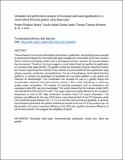| dc.description.abstract | Thermochemical conversion technologies (incineration, gasification, and pyrolysis) have emerged
as potential technologies for municipal solid waste management. Incineration is the most common
thermo-chemical technology widely used in developing countries; however, the process pollutes
the environment. Therefore, this study suggests a novel hybrid fixed bed gasifier for gasification
of municipal solid waste (MSW). The gasifier model was developed using the Advanced System
for Process Engineering Plus (ASPEN Plus) software to accommodate the four gasification stage
(drying, pyrolysis, combustion, and gasification). The aim of developing a novel hybrid fixed bed
gasifier is to combine the advantages of downdraft and cross-flow gasifiers in one system and
minimize its disadvantages. This combination has revealed the way to a gasifier design that
accommodates feedstock with high moisture content (≈ 60%) while maintaining or improving
syngas output composition. The analysis of operating parameters such as temperature and
equivalence ratio (ER) was also investigated. The results showed that the moisture content (MC)
was reduced from 59.8 wt% to 6.8 wt%. The syngas output was highly affected by the changes in
temperature as well as ER. High temperature increases H2and CO output composition. The
behavior was different for the case of ER where it was observed that H2 and CO decreases while
CO2 andH2Oincreases between ER = 0.1 to 0.4 and then starts decreasing gradually. In general,
the developed hybrid fixed bed gasifier exhibited an increase inH2 and CO in the producer gas. At
this situation, the carbon conversion efficiency of 62.35% and a gasifier conversion efficiency of
54.5% were realized. This suggests the suitability of hybrid | en_US |

